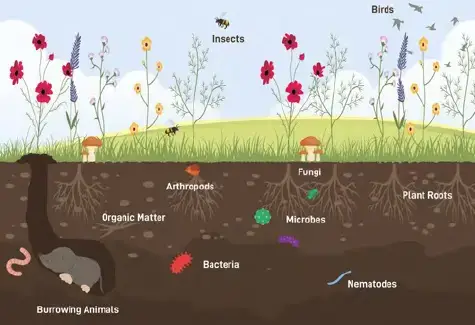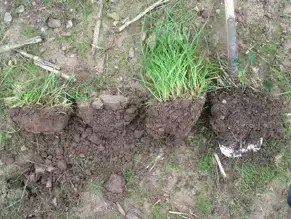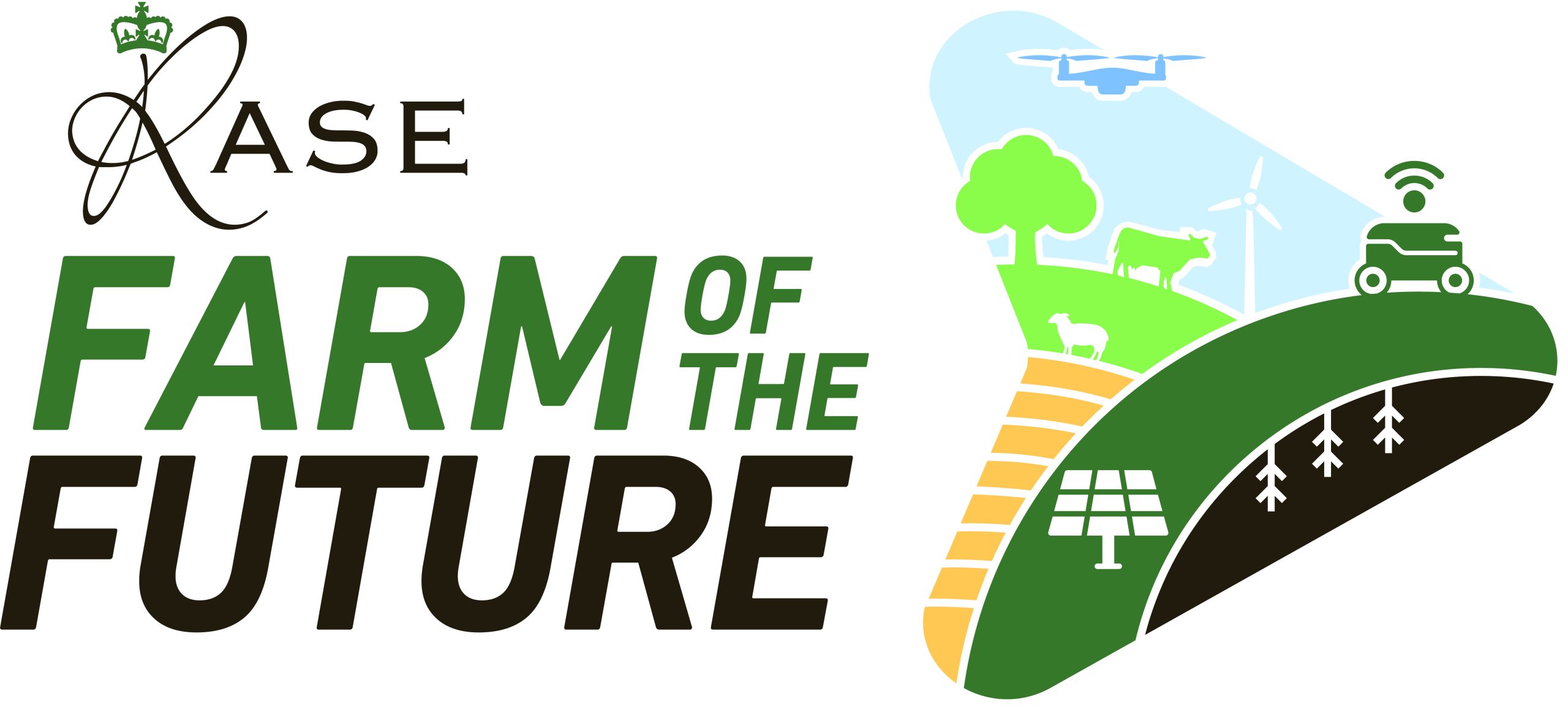by John Cherry
Much can be learned from studying soil. It is a bewilderingly complex ecosystem with millions of species of bacteria, fungi, viruses and many more microscopic organisms in a wonderful food web which ends up with earthworms, insects and beetles, that can actually be seen. While there is a lot of ‘nematode eats bacteria’ action, there is also an extraordinary amount of symbiotic interaction where fungi and bacteria help each other and the growing plants.

Soil biology and diverse landscapes
Carbon capture and storage
At present there is, quite rightly, a focus on limiting the release of greenhouse gases, particularly CO2. But there is already too much CO2 in the atmosphere and so the excess also needs to be removed. Carbon capture and storage can be done very cheaply by plants grown in soil (or very expensively by high-tech inventions) as plants remove CO2 from the air and turn it, via photosynthesis, into sugars which are the building blocks they need to grow.
Depending on circumstances, a large proportion of these sugars (up to 70%) are exuded directly into the soil to feed bacteria and fungi which cluster around the plant root, exchanging other nutrients and water with the exuded carbohydrates. This symbiotic transaction is at the core of how farming can support the global transition.
Soils vary enormously, but nearly all of them are improved by increasing carbon. But nearly all of them are improved by increasing carbon. Importantly, stable soil organic matter (humus) can absorb six times its own weight in water, as well as supporting other microscopic soil dwellers, which all help to create a sponge-like soil structure with capacity to absorb rainfall more effectively and help prevent flooding while mitigating the effects of drought.

From right to left: Soil sample from under the hedge bordering a field, showing good soil organic matter; re-seeded grass established by non-inversion shallow soil loosening; re-seeded grass established in the same manner, but drilled 3 weeks later showing slumped soil surface; compacted soil sample from the field margin.
Soil regeneration
Most agricultural soils are degraded to some extent, but they can be rapidly regenerated by sympathetic regenerative farming methods. This can take a longer time in some soils, but anecdotal evidence suggests that regeneration to a meaningful degree can be achieved in as little as five to seven years.
There are five key principles at the heart of this approach:
- Understand the context to ensure practices align with each farm’s unique environment, soil, climate and goals. Understanding context enables tailored approaches to enhance soil health, biodiversity and resilience. Without context, regenerative efforts risk inefficiency or failure.
- Minimise disturbance of the soil, both physically and chemically. The micro-flora and fauna that form the soil ecosystem are harmed by cultivations, especially ploughing, which inverts the top few inches. There is often a nutrient boost from aggressive cultivating; resulting in short-term release of nutrients during a long-term decline as many underground ‘workers’ are killed or rendered homeless and get eaten by predators or scavenging arthropods. Similarly, heavy fertiliser or pesticide use will upset the delicate balance where healthy soil is created. For example, too much nitrogen will upset the carbon-nitrogen ratio and encourage microbes to eat organic matter and set any improvement back.
- Keep the soil covered, either with living plants (green cover crop) or a mulch of crop residue, like chopped straw. This protects the soil from rain impact, reducing the damage that high speed raindrops will do to the surface and allowing the water to percolate gently down. A good soil cover will also stop overheating by hot sun or freezing in winter, both of which are antagonistic to healthy soil.
- Maintain living roots in the soil for as much of the year as possible. Living roots are the conduit that feed the soil. In conventional arable systems the soil is often left bare for months at a time, but by planting cover crops the underground ecosystem can be kept functioning.
- Maintain as much plant diversity as possible. Monocultures are an anathema to nature and restrict the variety of soil creatures that can be supported. A diverse population of plants can be grown in companion cropping systems, where two or more crops are grown simultaneously and are harvested together with the seeds being separated post-harvest. More conventionally, robust crop rotations ensure healthier soil and reduced weed and disease pressure. There is also potential for growing crops through a living mulch of clovers which stay close to the ground and allow the cereal to tower above and be harvested when ripe, leaving the understory to carry on feeding the soil and fixing nitrogen.
- Reintroduce livestock into the system. There will already be trillions of living creatures in the soil and incorporating grazing livestock into the farming system will turbo-charge their numbers and increase the biodiversity to the benefit of the soil, as well as adding to the farm income. A diversity of farm animals (cows, sheep, chickens, pigs and goats) will further boost soil fertility and support animal health.
These principles work on any farm worldwide, if they are applied within the local context of soil types, climate and markets for produce. From this basic framework, all sorts of ideas are being trialled on farms up and down the country. Some systems are including trees, as in agroforestry, silvopasture or full-grown permaculture. All these ‘stack’ systems and greater biodiversity onto each hectare, producing more income streams for the farmer.
Agroforestry
Agroforestry usually consists of arable crops being grown between rows of trees planted 25-40 metres apart. The trees help create a beneficial microclimate for the row crops, protecting them from wind and overheating, as well as foraging deep into the soil for nutrients which would otherwise be unavailable for the crops and spreading them on the surface in the form of leaf-litter in the autumn. Leaves also make a good mulch.
Trees recycle nutrients from deep in the soil to near the surface. Importantly, the tree roots and canopy are managed to occupy different space than the annual crop, and to use different resources of sunlight, water and nutrients in different periods of the year to minimise competition.
Silvopasture
Silvopasture involves integrating trees within grazing landscapes. Trees provide protection from wind, sun and rain for livestock, as well as a certain amount of browsing potential (grazing of foliage). This is often very beneficial to animal health as the browsers can access minerals that might be otherwise unavailable. In both these scenarios, the trees also give extra income, either from fruit/nut harvesting or periodic timber/wood chip harvest.
‘No-till’ farming
‘No-till’ farming is becoming more popular as farmers see the benefits of farming in a more enlightened way, using less cultivating machinery, fewer tractors and, as their soil improves, less chemical fertilisers and sprays. On its own, no-till might be just observing the first principle above, but it won’t work properly unless the first four tenets, at least, are followed. Luckily, most farmers who start down this route, soon become obsessed with their soil and want to do all in their power to nourish it.
Showing farmers how to make their operations more economically and environmentally resilient is the best method to effect change. Groundswell is an annual show and conference – an on-farm low carbon demonstration event designed to showcase ideas and techniques to farm more sustainably.
Alternative funding streams
There are emerging alternative streams of funding for regenerative systems, like carbon trading and Green Bonds which will reward farmers for locking up carbon and for flood prevention. Green Bonds are new to the UK, but they will enable insurance companies to reduce their exposure to flood damage by helping landholders to prevent floods from happening. Everyone would be a winner! The Government could offload much of the expense of subsidising farming to the private sector, insurance will become cheaper and farmers and the environment will be better off.
The lessons to be learned from the interspecies cooperation in the soil food web, where a myriad of microscopic creatures work in harmony, can thus be extended to human-scale, to create food systems that produce nutrient dense food, at the same time as looking after the other creatures and their biomes, with whom we share the planet.
